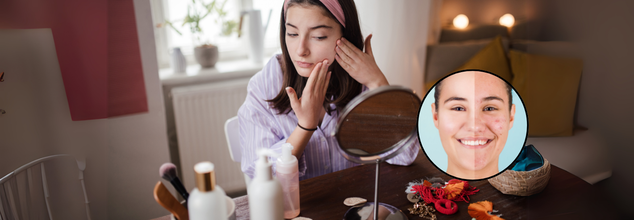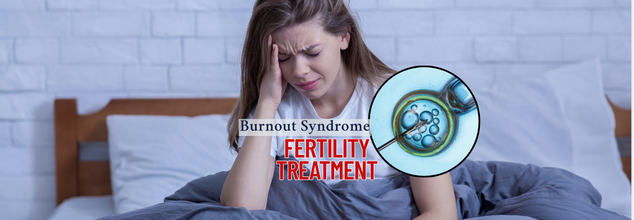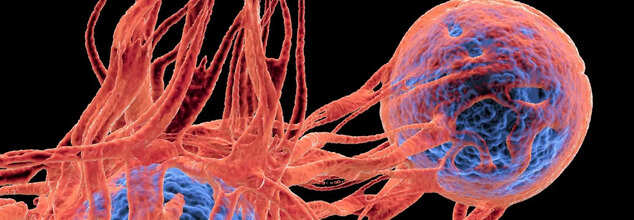
Image Credit: Canva
Skincare Expert Says Begin Your Teenager's First Skincare Routine With This Habit To Stay Acne-Free
As a teen the biggest problem is the struggle with breakouts, oily skin, and stubborn acne! Teenage skin changes dramatically, and without a good skincare routine, those annoying zits and pimples can linger. But we have some good news: we're about to share with you a super easy daily habit that can keep your skin clear and radiant.
Incorporating skincare routines into daily lives does not only enhance skin wellness but also educates adolescents on the importance of self-preservation and cleanliness. When adolescents know how their skin type works and what it needs, they feel better about themselves. This enhances self-confidence and urges them to do more for their health in general.
According to skincare specialist Abolee Chandrayan, developing the right habits in the teenage years is important to keep skin clear and healthy. "Teenage years are a big transition from soft baby skin to a more mature skin texture. Because of hormonal changes, teens tend to have acne, oiliness, or dryness. Having a good skincare routine during this time prevents long-term skin problems and encourages radiant skin," says Chandrayan.
What Causes Teenage Acne?
As one ages, hormone levels fluctuate, and the skin responds to this. Teenage acne is commonly fueled by overproduction of oil caused by hormonal changes. Other factors like genetics, stress, and comedogenic cosmetics may also play a part in causing pimples.
Common Forms of Teenage Acne
Whiteheads: Tiny, flesh-colored or white bumps formed due to the plugging up and closing of pores.
Blackheads: Blackheads are not due to dirt, contrary to popular belief, but to open pores that get clogged and oxidized.
Papules and Pustules: They manifest as tiny, red bumps (papules) or pus-filled spots (pustules) popularly known as pimples.
Nodules and Cysts: Severe forms of acne that form deep in the skin, which may need dermatological intervention due to inflammation and pain.
Why Skincare Is Essential for Teens?
Teen skin is very sensitive caused by over-production of oil, pollution exposure, and hormonal surges. "A well-formulated skincare regime not only aids in controlling acne but also promises long-term well-being of the skin. Teaching teenagers the benefits of skincare in early life is important," suggests Chandrayan.
Adolescents with combination or oily skin tend to develop enlarged pores and blackheads, whereas dry and sensitive skin-prone teenagers suffer from sensitivity against chemicals and sunlight. It thus becomes absolutely crucial to use appropriate skincare products in accordance with one's own skin requirements.
The 3-Step Teen Skincare Routine
A teen's skincare routine should ideally comprise three elementary steps to provide a strong basis for achieving clean skin.
1. Cleansing
"Cleansing is the initial and most important step towards having healthy skin. Teenagers must wash their face twice a day with a mild cleanser appropriate to their skin type," recommends Chandrayan. A good cleanser cleanses away dirt, oil, and grime without causing breakouts. Sulfate-free and non-comedogenic formulas are best to keep them away from excess dryness and irritation.
2. Moisturizing
Daily application of a moisturizer is crucial, even for oily skin. "Many adolescents avoid moisturizers in fear that they will aggravate acne, but the right moisturizer will rebalance oil production and keep the skin barrier healthy," says Chandrayan. Oily or acne skin teens should use light, oil-free, and non-comedogenic moisturizers, whereas those with dry skin need to use a hydrating product containing ceramides or hyaluronic acid.
3. Sun Protection
Sunscreen is an essential skincare product, irrespective of skin type. "Sun protection is not negotiable for teenagers," opines Chandrayan. "Applying SPF 30 or more on a daily basis—irrespective of weather conditions—prevents premature aging, hyperpigmentation, and skin damage due to UV radiation." Oily skin teenagers must use a matte, oil-free sunscreen to prevent greasiness.
Adolescents must avoid applying random or extremely harsh skin care products. They should, instead, use dermatologist-tested formulas containing gentle, plant-based ingredients. "A COSMOS-certified organic skin care brand with willow bark and basil as its ingredients can gently cleanse and care for the skin without harming the environment and animals," advises Chandrayan.
Long-Term Habits for Healthy Skin
Skincare is not all about products—it's about lifestyle choices. "What you eat also has a major impact on the health of your skin. If you're eating a lot of processed foods and refined sugars, it can worsen acne," Chandrayan cautions. "Teenagers should have an omega-3 fatty acid-rich diet with plenty of fruits and vegetables and hydrate with plenty of water to keep them well-hydrated."
Other than skincare products, consistency is the way to go. "Results won't show overnight. Skincare is a long-term process, and having a routine with discipline is important," Chandrayan suggests.
Mr Abolee Chandrayan is a Skincare Expert and Head of Research & Development at Puddles in India

When To Take A Break From IVF Treatment After Failed Cycles?
Starting on journey of in vitro fertilization (IVF) is a very personal and emotional process. For most couples, it is a hope—a chance to maybe finally be able to achieve their dream of having a family. But what isn't discussed nearly enough is exactly how physically, emotionally, and financially draining this process can be.
Between countless doctor visits, daily hormone injections, unpredictable outcomes, and the immense pressure to succeed, IVF can start to take a serious toll. It’s not just about the body; it affects the mind, relationships, and overall well-being. This is why taking a break—stepping back to breathe and reset—can be an essential part of the process.
But how will you know when it's time to stop? And perhaps more important, how do you handle the emotional burden of deciding? If you find yourself drained, overwhelmed, or wondering if you should continue, know you are not alone. Here's what you need to know about IVF burnout, why it occurs, and how stopping might actually advance you.
For most couples, having children is a dream come true. When natural conception is no longer possible, in vitro fertilization (IVF) is usually the light at the end of the tunnel. Although the progress in fertility treatments has enabled many couples to conceive, the process is not an easy one. IVF is a time-consuming, costly, and emotionally draining process that demands an unrelenting commitment. The endless cycle of doctor visits, hormone shots, procedures, and waiting can be draining on both partners.
Although promising, IVF is not an assured route to success. Failed cycles, cycles of repeated disappointments, and uncertainty about the process can result in severe emotional distress. Most couples feel feelings of shame, guilt, frustration, and anxiety, so it is vital to know when a break is necessary.
What is IVF Burnout and Why Does It Happen?
Dr. Vandana Ramanathan, Fertility Consultant at GarbhaGudi IVF Centre, describes IVF burnout as a condition of mental and physical fatigue resulting from extended treatment. "This fatigue can be caused by repeated failed cycles, long procedures, and uncertainty of results," she adds.
Unlike most other medical treatments, IVF has a strong emotional component. Each cycle costs the couple considerable amounts of financial, physical, and emotional capital, often creating unbearable pressure on their part. Not only is there medical stress involved, but social pressures and a lack of support also add to the experience and lead to burnout.
Recognizing the Signs of IVF Burnout
Burnout also appears in different ways to every person, based on their stress-coping mechanisms. The symptoms can be divided into mental and physical symptoms:
Mental Signs:
- Enduring depression and anxiety
- Irregular mood swings and heightened irritability
- Lack of motivation and interest in daily tasks
- Social isolation and withdrawal
Physical Signs:
- Chronic fatigue and exhaustion
- Sleep disturbances, including insomnia
- Gastrointestinal disturbances and changes in appetite
- Headaches and body aches occurring frequently
- Panic attacks and palpitations
- Hypertension and blood sugar fluctuations caused by stress
When Do You Need to Take a Break?
It's always hard to admit that you need a break when you've invested so much in the journey. But taking a step back doesn't translate to quitting—it's about taking care of yourself as a whole. Dr. Ramanathan says that taking a break doesn't lower the success rate of IVF procedures. Moreover, it can be helpful. If the patient is not ready physically or psychologically for the next cycle, chances for success may be affected as well. We usually suggest taking a break for several months before resuming," she elaborates.
Some couples realize this on their own, seeing that the process is exhausting them. Others might require their doctor to advise them. Either case, a break can last anywhere from a month to six months, depending on the couple's state of mind. The objective is to restore emotional balance and make sure that both partners are mentally ready for the next step in treatment.
How to Manage IVF Burnout and Gain Emotional Balance?
Prioritizing Self-Care
Self-care is one of the most important things about breaking the cycle of IVF burnout. Stress can be controlled by practicing yoga, meditation, and breathing exercises. "The patients need to engage in relaxation activities that allow them to feel in control of their emotions," states Dr. Ramanathan.
Having a Balanced Diet
IVF processes use high doses of medication, and therefore adequate nutrition is key. A well-balanced diet full of vitamins, minerals, and hydration benefits the body throughout the process and also aids in stress management.
Adequate Sleep
Sleep tends to be interfered with because of stress, but sleep is crucial to well-being. A minimum of six to eight hours of rest will help the body heal.
Adding Exercise
Physical activity can serve as an excellent stress reliever. Whether it’s walking, yoga, or any preferred form of exercise, staying active for at least an hour a day can help balance hormones and improve mental health.
Open Communication
IVF is not only a physical procedure—it's emotional too. Couples must be open with one another and their physician. Talking about fears, challenges, and expectations can ease emotional burdens. "If couples feel they cannot manage the stress themselves, professional counseling can be very helpful," says Dr. Ramanathan.
Setting Realistic Expectations
Knowing that IVF is a hard process with setbacks is the bottom line. Different people react in different ways to treatment, and outcomes can differ. Acknowledge these unknowns and be realistic about expectations in order not to burn out.
Why Taking a Break is Not Giving Up?
Time off from IVF is not failure. Rather, it is a chance to rest, recharge, and come back to the process with renewed vigor. "Patients who take a break often return feeling more optimistic and emotionally prepared," Dr. Ramanathan reports.
If you find it too much, taking a break for a while can be the best option for your physical and mental health. When things are ready, you can go back to the process with a new mind and a better attitude.

Credit: Canva
These 4 Signs Can Help You Identify Cavities-And What You Should Do
Cavities are one of the most common dental issues, yet they often go unnoticed until the problem worsens. I, myself, have faced this!
Cavities, commonly referred to as tooth decays, are caused by bacteria in plaque using sugars and starches. The bacteria in your mouth form a sticky film that causes plaque in teeth. Every time you eat or drink anything with sugar or starch, this bacteria in plaque breaks them down, producing acids. These acids eventually lead to enamel erosion. Over time, the enamel weakens and breaks down, forming a cavity or a hole in the tooth.
Recently, dentist and social media influencer Dr Lavina Kumar, highlighted four key signs that could indicate the presence of a cavity—and why you shouldn’t ignore them.
In the video, she explained that tooth sensitivity, especially when consuming cold drinks, could be an early warning sign. Persistent toothache, food frequently getting stuck between teeth, and the sensation of a hole in your tooth are also strong indicators that a cavity may be developing.
The NHS also warns that tooth decay can manifest as sharp pain when eating or drinking hot, cold, or sweet foods. Visible white, brown, or black spots on the tooth may also signal decay.
However, treatment is possible. Based on the severity, you dentist can offer you different options. Early-stage cavities can sometimes be reversed with fluoride treatments such as mouthwash or varnish. However, if decay progresses, a filling may be required. In severe cases, a root canal or even tooth extraction may be the only remaining solution.
Tooth Decay: Do’s and Don’ts
To avoid tooth decay and maintain strong teeth, consider the following tips:Do’s
- Brush Before Breakfast: UK dental surgeon Shaadi Manouchehri advises brushing before eating breakfast to remove the bacteria that builds up overnight. This practice shields your teeth from acidic food and drinks that can weaken enamel.
- Choose Healthy Snacks: Opt for raw vegetables, nuts, or fruits that are low in sugar and require chewing, which stimulates saliva production and naturally cleans the teeth.
- Use Xylitol Gum: Chewing gum with xylitol after meals can boost saliva flow and reduce the risk of cavities.
- Wait Before Brushing After Meals: If you prefer to brush after eating, wait at least 30 minutes to allow your enamel to re-mineralize and harden.
Don’ts
- Avoid Sugary Snacks: Fermentable carbohydrates, such as chips, crackers, and cereal, turn into sugars that fuel the growth of harmful bacteria in the mouth.
- Skip Brushing After Acidic Meals: Acidic foods and drinks can weaken your enamel. Brushing immediately after consumption can wear away the softened enamel, leading to cavities.
- Don’t Skip Hydration: Drink water after meals to help neutralize acids and wash away remaining food particles in your teeth.
Maintaining optimal dental health takes more than just brushing and flossing twice a day. Adding such healthy eating habits, timing your brushing routine, and using xylitol gum after meals, you can protect your teeth from decay and promote stronger enamel.

Credit: Canva
Not All Tumors Are Cancerous: Understanding Benign Tumors
All cancers are tumors, but not all tumors are cancers. Tumors can either be benign (non-cancerous) or malignant (cancerous). The first type, that is benign tumours do not spread to other parts of the body. They grow slowly and typically remain confined to one location. Although they are not cancerous, some benign tumors may cause health issues if they press on vital organs or nerves.
On the contrary, malignant tumors are cancerous growths that can invade nearby tissues and spread (metastasize) to other parts of the body. Common metastatic sites include the liver, lungs, and bones. For instance, pancreatic and colon cancer commonly spread to the liver, while breast cancer and melanoma can metastasize to the brain.
Here Are Key Differences Between Tumours And Cancers
Cancer is a disease, whereas tumors can be either benign or malignant. Cancer is always malignant and has the potential to spread, while some tumors are benign and pose minimal health risks.Cancer consists of malignant cells, whereas tumors are not always malignant. Benign tumors do not invade nearby tissues or spread to other body parts.
Cancer can be life-threatening, while tumors may not be. Malignant cancers can spread and cause severe complications, whereas benign tumors often remain localized.
Cancer spreads through metastasis, but tumors do not always do so. Malignant tumors can invade other organs, while benign tumors typically stay confined to one area.
What Causes Cancer?
Cancer results from a combination of genetic, environmental, and lifestyle factors. Genetic mutations can be inherited or occur due to external exposures such as tobacco smoke, ultraviolet radiation, and carcinogenic chemicals. Lifestyle factors like poor diet, lack of exercise, and excessive alcohol intake also increase the risk. Chronic infections from viruses like HPV and hepatitis B and C can further predispose individuals to certain cancers.How Cancer Spreads
Cancer spreads through metastasis, where malignant cells break away from the primary tumor, travel via blood or lymphatic vessels, and establish new tumors in distant organs. This process significantly impacts cancer prognosis and complicates treatment.
ALSO READ: Why Ayurveda Says Your Morning Tea Should Do More Than Just Wake You Up
Treatment Approaches: Tumor vs. Cancer
Treatment varies based on whether a tumor is benign or malignant. Benign tumors may only require monitoring or surgical removal if they cause symptoms. Cancer treatment, however, is more intensive, often involving surgery, chemotherapy, radiation therapy, immunotherapy, or targeted therapy. A multidisciplinary approach is typically adopted to ensure the best outcomes.
Importance of Early Awareness
Understanding the difference between tumors and cancer is crucial for informed health decisions. Early diagnosis and timely intervention can significantly improve treatment success rates. Whether benign or malignant, all abnormal growths should be evaluated by a medical professional to ensure appropriate care and management.
ALSO READ: From Anemia To Cancer: The Life-Threatening Illness No One Saw Coming
© 2024 Bennett, Coleman & Company Limited

